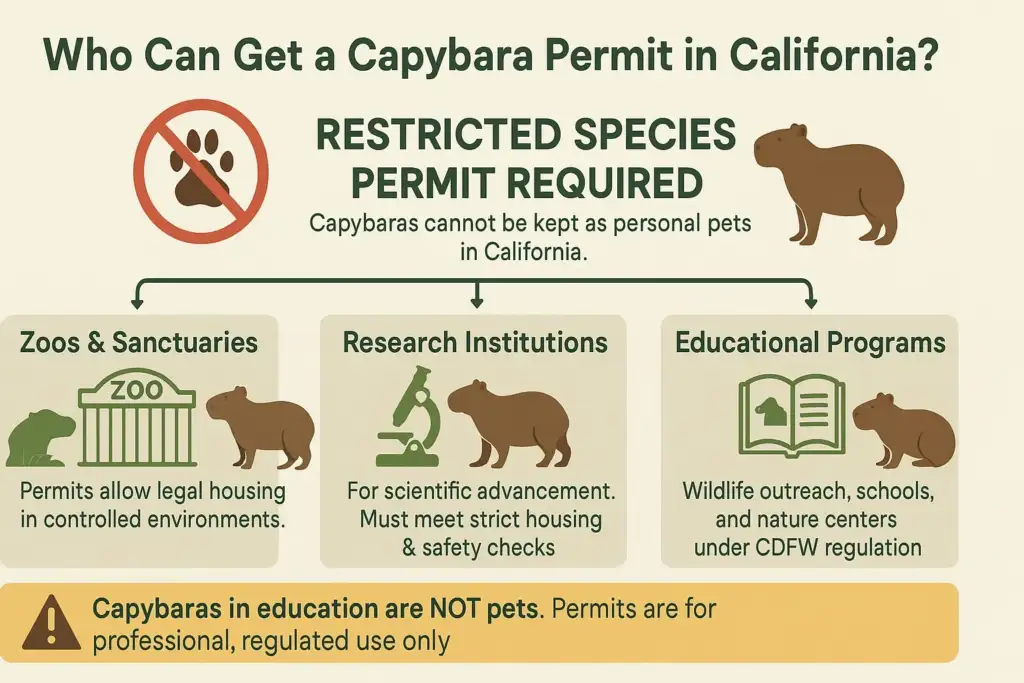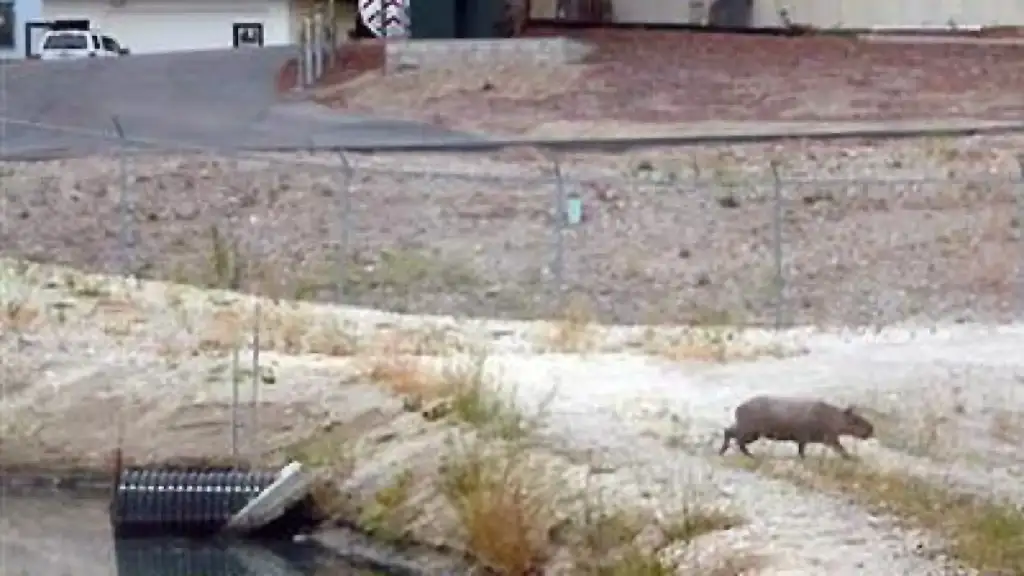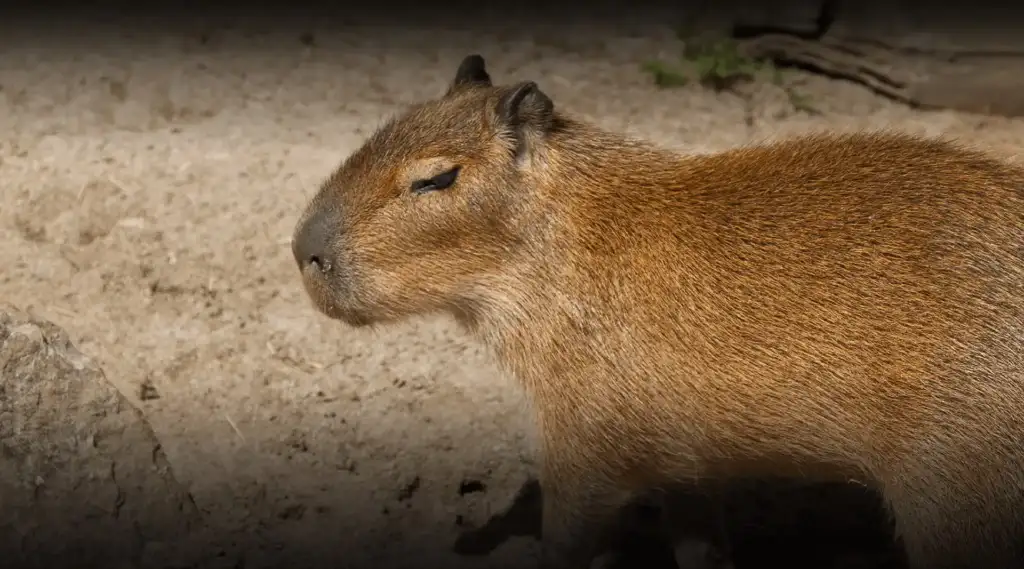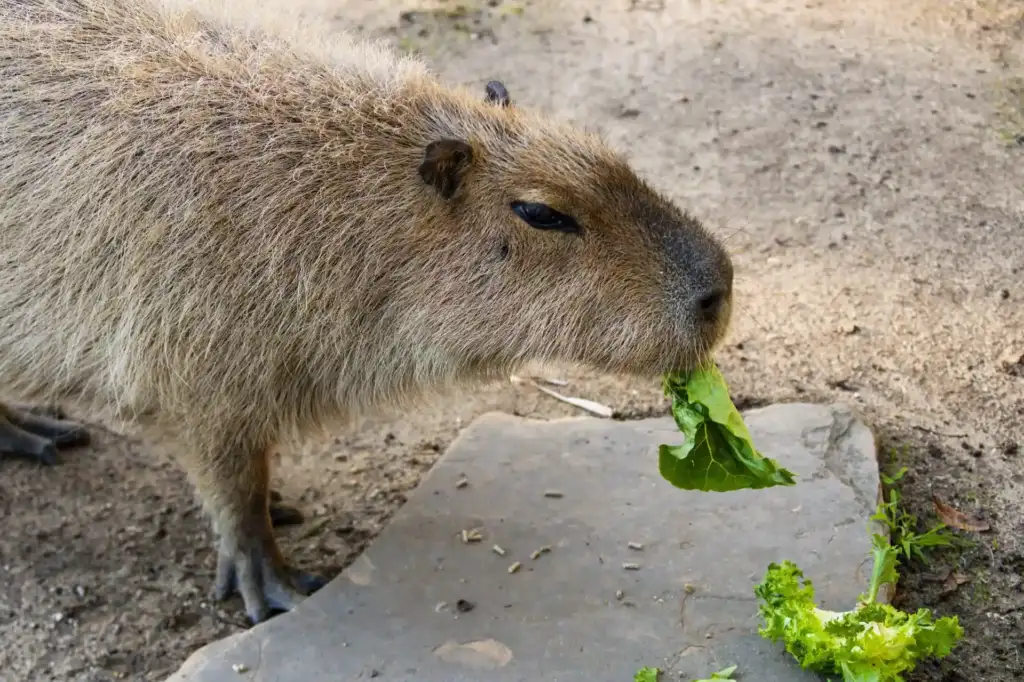Why Do Capybaras Ride Crocodiles? Reality or AI?
August 11, 2025Capybara vs. Nutria: Unmasking the Differences Between Semi-Aquatic Mammals – A Detailed Guide
August 21, 2025Can you own one?
No, capybaras are illegal in California as pets without a special permit–and those are nearly impossible to get unless you are at the zoo. Despite their calm and friendly nature, the California Department of Fish and Wildlife (CDFW) lists them as a restricted species due to their invasive potential.
Why are capybaras banned?

California has banned capybaras because of their invasive nature. California Department of Fish and Wildlife (CDFW) marks them “INVASIVE” because of the following reasons:
- Out-compete Native Species: Capybaras can out-compete native species in terms of food and shelter. They are efficient grazers and can alter the vegetation, leaving native species with little to no food.
- Lack of Natural Predators: In California, native predators such as coyotes, bobcats, and mountain lions are unable to control the capybara population effectively. Because they are unfamiliar with natural behaviour and size constraints.
- Rapid Reproduction: A single female capybara produces several offspring per annum (usually 4-5 pups). This rapid reproduction gives them a population growth advantage over slower-reproducing native species.
- Safety Reasons: Capybaras’ friendly behaviour is habituated, not domesticated. They can exhibit signs of stress when in human presence, prompting them to bite (one of their survival tactics). It means they are not cuddly when stressed, having a 150 PSI bite force.
- Disease Transmission: Capybara could potentially introduce or amplify parasites and diseases (like ticks or pathogens) that affect wildlife, livestock, or even humans.
Exception and Permit:
Restricted Species Permits are mandatory for any entity intending to import, transport, or possess restricted animals, including capybaras. These permits are typically issued to organizations that serve specific purposes, such as:
- Advancement of science
- Education
- Public health or welfare
A significant number of people in California desire capybaras as pets. However, legal restrictions prevent them from doing so. But some institutions can get a special permit to pet capybara for research and study purposes.
- Zoos and Animal Sanctuaries:
Zoos and animal sanctuaries can get this permit as they have a controlled environment to provide for capybaras. In this way, they can house a capybara legally.
- Research Institutions:
Research institutes can also get permits for the advancement of science. In order to get a permit, they should have some necessary arrangements to house a capybara. Government bodies always check these arrangements occasionally to ensure the safety of the capybara.
- Educational Programs:
Educational programs–such as wildlife outreach organisations, nature centres, or schools that are conducting live animal demonstrations can also get permits to keep capybara in California. But they have to observe strict conditions regulated by the California Department of Fish and Wildlife (CDFW).

Important Note:
Capybaras used in education cannot be treated as personal pets. The permit is strictly for professional, regulated educational use.
How to Get Restricted Species Permit?
To legally possess capybaras in California for educational purposes, organizations must obtain a Restricted Species Permit from the California Department of Fish and Wildlife (CDFW). Here’s a step-by-step guide to the application process:
1. Determine Eligibility
- Purpose: Ensure your organization qualifies under educational use, such as wildlife education programs, nature centres, or schools conducting live animal demonstrations.
- Compliance: Verify adherence to local, state, and federal regulations regarding restricted species.
2. Obtain and Complete Application Forms
- Restricted Species Permit Application (Form FG1312): This form collects information about your organization, the intended use of the capybaras, and details about the animals.
- Restricted Species Inventory of Animals (Form FG1313): Provide specifics on the number, species, and identification of the capybaras you intend to possess.FWC
- These forms can be accessed on the CDFW’s official website under the Licensing section.
3. Prepare Supporting Documentation
- Educational Program Details: Outline the educational objectives, target audience, and how the capybaras will be utilised in your programs.
- Facility Description: Provide a detailed description of the housing facilities, including dimensions, materials, and photographs or diagrams.
- Emergency Action Plan: Develop a plan addressing potential emergencies, ensuring the safety of both the animals and the public.
4. Ensure Compliance with Facility Standards
- Review and comply with the Minimum Facility and Caging Standards as specified in Title 14, Section 671.3 of the California Code of Regulations.
- Ensure enclosures are secure, humane, and appropriate for capybaras, meeting specified size and structural requirements.
5. Submit Application and Fees
- Application Fee: Include the non-refundable application fee with your submission. As of 2025, the fee is $151.67 for new applications. Cal Fish and Wildlife
- Submission: Mail the completed forms and supporting documents to the CDFW’s License and Revenue Branch at the address provided on the application forms.nrm.dfg.ca.gov+1nrm.dfg.ca.gov+1
6. Facility Inspection
- Coordinate with CDFW for an inspection of your facilities to ensure they meet regulatory standards.nrm.dfg.ca.gov
- Address any deficiencies identified during the inspection promptly.
7. Await Permit Approval
- The CDFW will review your application, supporting documents, and inspection report.
- If approved, you will receive your Restricted Species Permit, authorizing the possession of capybaras for educational purposes.
8. Maintain Compliance and Renew Permit
- Adhere to all permit conditions and regulations.
- Renew your permit annually by submitting the required renewal forms and fees before the expiration date.nrm.dfg.ca.gov
For the most accurate and current information, consult directly with the CDFW or visit their official website.
What are the penalties for breaking the Law?
As we know, owning a capybara in California is illegal and requires a special permit to do so.
What will happen if you decide to pet a capybara without a special permit?
There can be multiple consequences depending on the severity of the case.
- Fine: You can get a fine ranging from $500 to $10,000, depending upon the severity of the case.
- Confiscation: Authorities may seize your capybara. It could be relocated to some other zoos or native lands. But in some cases, a capybara can be euthanised.
- Criminal Charges: It is a misdemeanor, potentially leading to up to six months in county jail (CA Penal Code 597).
- Additional Costs: You are supposed to pay the expenses related to the animal’s removal, transport, or care.
These rules help to protect the local habitat and ensure animal welfare. Keep in mind that capybaras are non-native and require special care. Private owners cannot get permits so far. Always check with the California Department of Fish and Wildlife for current regulations before considering exotic pets.
What are the alternative options for you in California?
You can pet some other wild exotic animals that are legal in California.
Following is the detailed comparison of different animals you can pet with their expected petting cost and legal status in California.
| Pet | Initial Cost | Monthly Cost | Legality in CA | Daily Life Fit |
| Sugar Glider | $200–$500 | $50–$100 | Legal, check local rules | Night owls only: they’re up when you’re Netflix-binging at 1 a.m. Daily cage cleaning, chopping fruit, and bonding time. Tough if you’re out all day. |
| Hedgehog | $100–$300 | $20–$50 | Legal (domesticated) | Chill for busy folks: sleep all day, need 10 mins of evening feeding and cage tidying. Fits in a small apartment, but keeps it warm when you’re at work. |
| Guinea Pig | $20–$50 | $15–$30 | Legal | Easy for families: munch hay while you’re at school or Zoom calls. Quick daily veggie prep and cuddles. Loud wheeking might spice up your quiet mornings. |
| Rabbit | $30–$100 | $30–$60 | Legal | Flexible for homebodies: needs morning hay refills, evening playtime. Can roam your living room while you cook. Chew cables if you’re not watching. |
The 2011 Mystery: A Capybara Loose in Paso Robles
A Real Case Study
July 22, 2011: Nick Kamp, a worker at wastewater treatment in Paso Robles, California, sighted a 120-pound rodent paddling through the facility. It was not a beaver, not a nutria, but a capybara. This incident became a hot topic for local news, and many thought it to be an “Invasion”. Then CDFW came into action and revealed that this was a case of illegal pet escape.

The CDFW first planned to set live traps and move them to some zoos and other permitted facilities if needed. However, it wasn’t causing harm, so they chose to monitor the situation instead. No traps were laid, and the capybara was released without further sightings.
How do capybaras appear in California?
Capybaras are not native to California, and you won’t find any herd munching in the Sierra Foothills.
So how do they even show up here?
California’s rare sights aren’t from natural migration; data shows three other major causes:
| Source | Frequency | Example | Outcome |
| Zoo Escapes | Rare (1/decade) | 1996 LA Zoo breakout | Recaptured, no wild population |
| Illegal Captivity | 5-10 cases/year | 2012 Paso Robles pet | Confiscated, owner fined |
| Historical Imports | 1970s-1980s | Pre-ban private ownership | Laws banned further trade |
Sources: CDFW, LA Times, Journal of Wildlife Management.
What if capybaras invaded California?
If capybaras escaped and spread in California, they would eat a lot of grass, out-compete native species, and cost millions like feral hogs do now.
The following is the comparison graph between capybaras and feral hogs.
(Note: Capybara data is unproven estimated data, as they are not invasive in California.)
| Feature | Capybara | Feral Hog |
| Food per Day | 6-8 lbs of grass | 5-10 lbs crops |
| Babies | 4-8 pups | 4-12 piglets |
| Damage | Crops, wetlands | Crops, rivers |
| Cost | $500M+ (if many) | $800M (now) |
How does the California ecosystem stop a Capybara invasion?
Capybaras are native to South America’s lush wetlands. They can’t easily invade California’s wilds. Here are the key reasons why California’s ecosystem fights them off:
| Factor | How It Stops Capybaras |
| Dry Climate | Too hot and dry; they need wet areas |
| Predators | Coyotes and lions eat them, especially pups |
| Food Competition | Deer and rabbits take their grass |
| Tough Terrain | Rocky hills, few wetlands—not capybara-friendly |
How much capybara cost (if you somehow get a permit)?
Owning a capybara and patting one at home is extremely difficult, as they are classified as a restricted species in California (CDFW). Permits are rarely granted to individuals, and the process is complex and costly.
The following is the complete breakdown of the cost to keep a capybara at home in California:
Permit Cost and Process complexities:
The application fee is around $500. There is a major cost of $1000-$2000 for inspection and facility upgrades, plus an annual renewal cost $200-$500.
Difficulty: Permits are for zoos, research, or education, not pets. You need:
- Proof of two years’ experience with restricted species.
- A 1-acre enclosure with a 100 sq ft non-chlorinated pool.
- Inspections by CDFW to ensure welfare.
- 99% of individual applications are denied.
2. Petting at Home: Practical Challenges
Petting a capybara at home is tough, even with a permit, because of their needs:
- Space: Need 1 acre and a pool—most homes don’t qualify.
- Cost: $1,000-$3,000 to buy (black market), $500-$800 monthly for food, pool maintenance, and vet care. Only 12 exotic vets in CA, mostly in LA/SF.
- Behaviour: Gentle but may bite (150 PSI force) if stressed, risky for kids. Need two capybaras for social health, doubling costs.
- Health Risks: Carry ticks with diseases like Rocky Mountain spotted fever (Emerging Infectious Diseases, 2020).
Capybara Zoos in California:
You can see capybaras at the following zoos, but you should call or email ahead. There are a number of reasons why they may not be on display, so it’s best to check with zoo staff before you visit.
Southern California: San Diego Zoo
This is probably one of the most famous zoos in the world, and it’s no surprise they have capybaras. You can find them in the Elephant Odyssey exhibit. I love this part of the zoo because it’s a “mixed-species” habitat. This means the capybaras share their space with other animals like Baird’s tapirs and black spur-winged geese. It’s a great chance to see how different species interact, and frankly, it just feels more natural. It’s like a big, beautiful animal neighborhood! Plus, remember that time back in 2015 when the zoo welcomed four new baby capybaras? It was a huge deal, and the little ones were born right there on the exhibit to parents named Rosalina and Bowie. So cute!

Central California: Santa Barbara Zoo
If you’re cruising up the coast, the Santa Barbara Zoo is a must-visit. They have two capybaras named Antonio and Poppy. I’ve heard they’re quite the duo! What’s cool is they live in a habitat with giant anteaters, which is a pretty unique combination. Antonio came from the Montgomery Zoo in Alabama, and Poppy came from the Greater Vancouver Zoo. It’s awesome to think about how these two traveled so far to end up as roommates, sharing a home with anteaters. It just goes to show you what a small world it is, even for capybaras.

Northern California: Sacramento Zoo & Happy Hollow Park & Zoo
Heading further north, you’ll find capybaras at the Sacramento Zoo. I’ve heard they’ve had some baby capybara pups over the years, which is always a treat to see. There’s something special about spotting a whole little family waddling around.
Just down the road in San Jose, there’s a wonderful spot called Happy Hollow Park & Zoo. While it might not be a huge, sprawling zoo, it definitely has a ton of charm. Recently, they welcomed a new capybara named Donatello from the Sacramento Zoo. He’s now roomies with another capybara, Wendy, and from what I understand, they’re planning to expand their habitat. It’s a great example of how these parks are always working to give their animals the best possible homes.
Summing Everything Up:
Capybaras, while charming and sociable, pose significant ecological and legal challenges in California. Their classification as a restricted species by the California Department of Fish and Wildlife (CDFW) stems from their potential to become invasive, out-competing native species, rapidly reproducing, and introducing diseases. Strict regulations, including the requirement for a Restricted Species Permit, limit their presence to zoos, research institutions, and educational programs, making private ownership nearly impossible. The severe penalties for illegal possession—fines up to $10,000, confiscation, and even criminal charges—underscore the state’s commitment to protecting its ecosystems and ensuring animal welfare.
For those eager to experience capybaras, California offers safer and legal alternatives through visits to accredited zoos and sanctuaries, where these animals are housed under controlled conditions. The 2011 Paso Robles incident highlights the risks of illegal pet ownership, while the state’s dry climate, predators, and competitive ecosystems naturally deter capybara invasions. Instead of pursuing the costly and impractical dream of owning a capybara, Californians can explore legal exotic pets like hedgehogs or guinea pigs, which better fit urban lifestyles and comply with state laws, ensuring both environmental balance and personal satisfaction.
